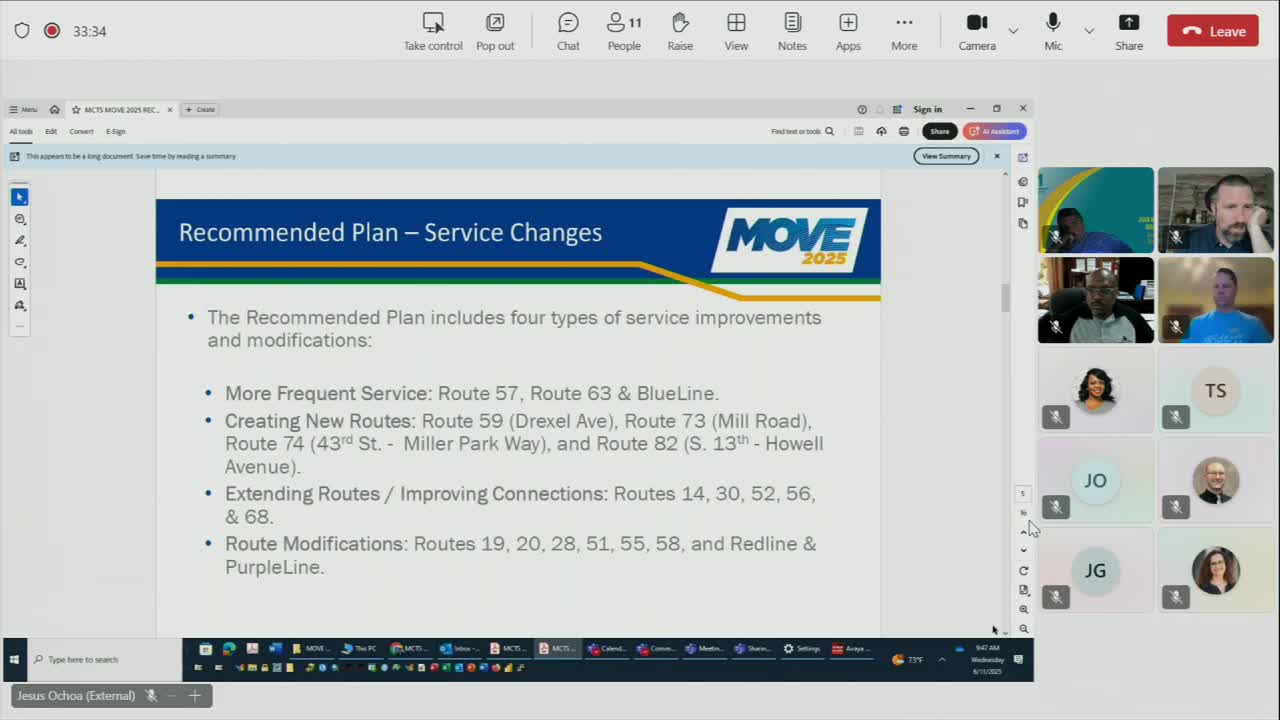Transit Authority announces new bus routes and increased service frequency in Milwaukee
June 11, 2025 | Milwaukee County, Wisconsin
This article was created by AI summarizing key points discussed. AI makes mistakes, so for full details and context, please refer to the video of the full meeting. Please report any errors so we can fix them. Report an error »

Milwaukee County's Committee on Transportation and Transit has unveiled an ambitious plan to enhance public transit services, responding directly to community feedback for more frequent and accessible routes. During a hybrid meeting held on June 11, 2025, officials outlined significant changes aimed at improving connectivity and service frequency across the county.
One of the most notable aspects of the plan is the introduction of four new routes, primarily derived from existing services. This restructuring is designed to simplify the transit system, making it easier for riders to navigate. For instance, the Blue Line will see its frequency doubled from every 30 minutes to every 15 minutes, extending service to Mill Road, a move that addresses long-standing requests from riders needing access to the Department of Health Services.
In addition to increased frequency on the Blue Line, Routes 57 and 63 will also see enhancements during peak hours, reflecting the high demand during morning and evening commutes. The new Route 59 will provide direct service along Drexel Avenue, connecting riders to major job centers like Drexel Town Square and IKEA, significantly reducing travel time for those in the South Shore area.
The plan also includes modifications to existing routes based on ridership trends. For example, Route 14 will be extended further west on Wisconsin Avenue, allowing better connections to key destinations, including Marquette University. Similarly, Route 30 will be adjusted to serve higher-density areas, improving access for residents.
Equity considerations were a focal point of the meeting, with officials confirming that the proposed changes would not disproportionately impact minority or low-income populations. A service equity analysis indicated that the plan would actually increase transit access for these groups, aligning with the county's commitment to equitable service distribution.
As Milwaukee County moves forward with these enhancements, residents can expect a more efficient and user-friendly transit system that better meets their needs. The changes are set to not only improve daily commutes but also foster greater connectivity across the region, ultimately supporting the community's broader goals for accessibility and mobility.
One of the most notable aspects of the plan is the introduction of four new routes, primarily derived from existing services. This restructuring is designed to simplify the transit system, making it easier for riders to navigate. For instance, the Blue Line will see its frequency doubled from every 30 minutes to every 15 minutes, extending service to Mill Road, a move that addresses long-standing requests from riders needing access to the Department of Health Services.
In addition to increased frequency on the Blue Line, Routes 57 and 63 will also see enhancements during peak hours, reflecting the high demand during morning and evening commutes. The new Route 59 will provide direct service along Drexel Avenue, connecting riders to major job centers like Drexel Town Square and IKEA, significantly reducing travel time for those in the South Shore area.
The plan also includes modifications to existing routes based on ridership trends. For example, Route 14 will be extended further west on Wisconsin Avenue, allowing better connections to key destinations, including Marquette University. Similarly, Route 30 will be adjusted to serve higher-density areas, improving access for residents.
Equity considerations were a focal point of the meeting, with officials confirming that the proposed changes would not disproportionately impact minority or low-income populations. A service equity analysis indicated that the plan would actually increase transit access for these groups, aligning with the county's commitment to equitable service distribution.
As Milwaukee County moves forward with these enhancements, residents can expect a more efficient and user-friendly transit system that better meets their needs. The changes are set to not only improve daily commutes but also foster greater connectivity across the region, ultimately supporting the community's broader goals for accessibility and mobility.
View full meeting
This article is based on a recent meeting—watch the full video and explore the complete transcript for deeper insights into the discussion.
View full meeting
